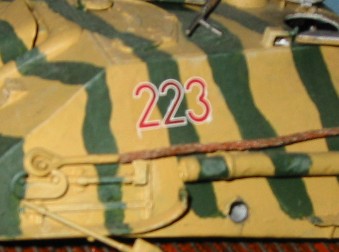A Writing Tip, from Building Model Tanks
I built model tanks when I was a kid. I had a How-To book of neat tips, including one that was actually about artistic intentions.
The German tanks in WWII had numbers on the turret. The numbers were usually painted at the assembly plant using a stencil, but sometimes the crews painted them by hand in the field, which of course had a crude look.
My How-To book said, if you want your model tank to look like one that had the numbers hand-painted by the crew, don’t try to paint the numbers by hand yourself. Because it won’t look intentional. It won’t look like you deliberately wanted to have crude-looking numbers; it’ll look like you lost the sheet of stickers that came with your model and tried to fake it by painting the numbers on.
Instead, my book said, use the stickers and paint some tiny drips of paint on top of them. It won’t look exactly like the real thing, but it will show what your intentions are–numbers that weren’t done with a stencil. And in that context, it’ll look right.

The audience for your art–whether model Jagdpanther or short fiction–gets some of their context for interpreting the art from their perceptions of your intentions. They will assume standard intentions for normal things, like that a knight embarking on a quest must be seeking some goal. But for non-standard things, they may not see your intentions. So they may not feel that context, and they may not be able to tell whether an oddity is intentional or a mistake.
I see this in stories I read for BCS. Sometimes there are incidents of odd punctuation or strange verb tenses, or passages of odd voice. If there’s no context for why the writer is doing that, it can seem like they had no reason, or that they’re not doing it intentionally at all; that it’s sloppy writing or a typo.
But if they do have a reason, the prose needs to indicate that. Not necessarily what the reason is; just that there is one. To “telegraph” to the reader that yes, there is method to my madness; this odd thing is intentional, not a typo.
So the reader doesn’t get jarred by the oddity, or bumped out of the story as they wonder whether it is intentional or just sloppy. So they immediately know that it is deliberate, and they can get back to normal readerly things, like pondering what the oddity means within the rest of the story. Back to reading.
Tags: HM, my magazine, writing


